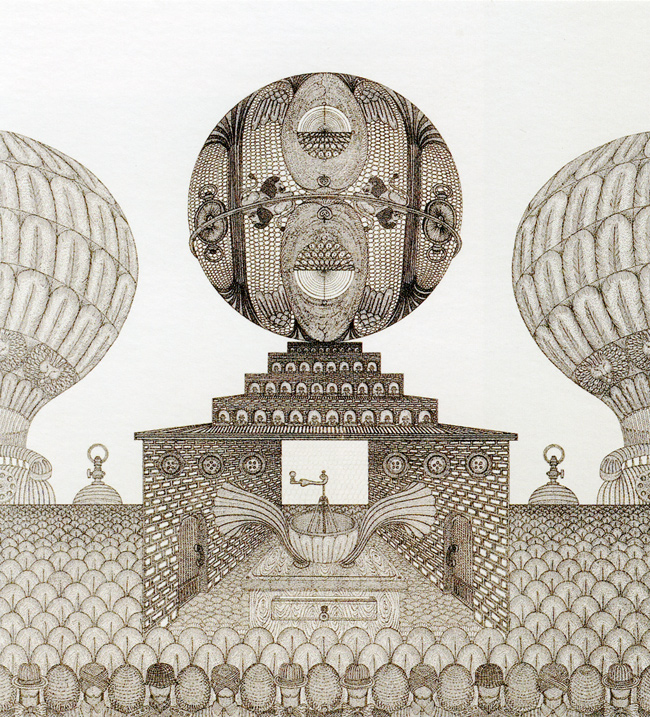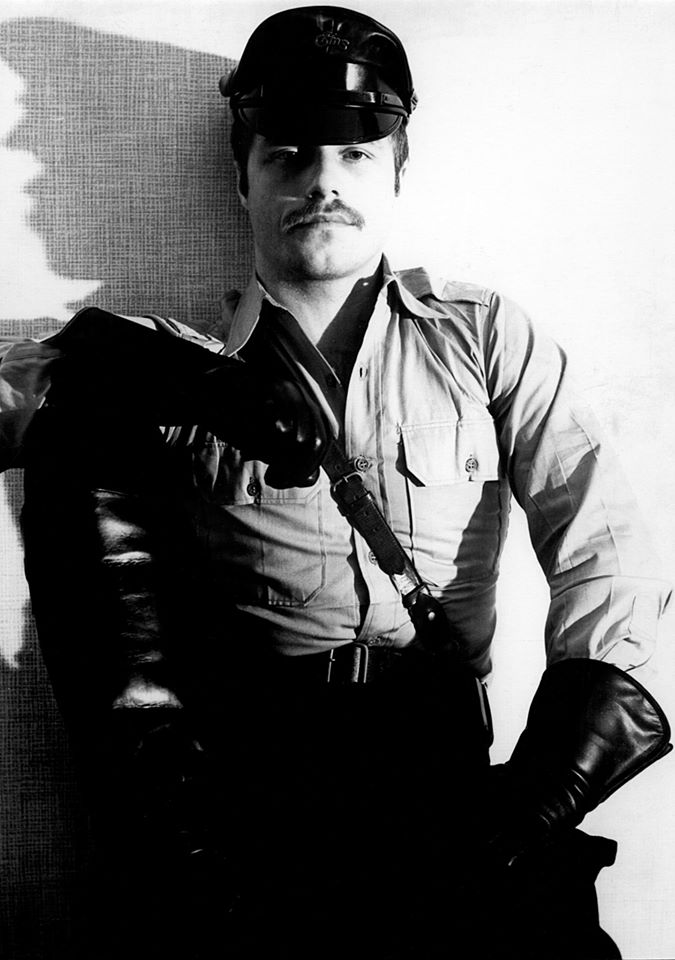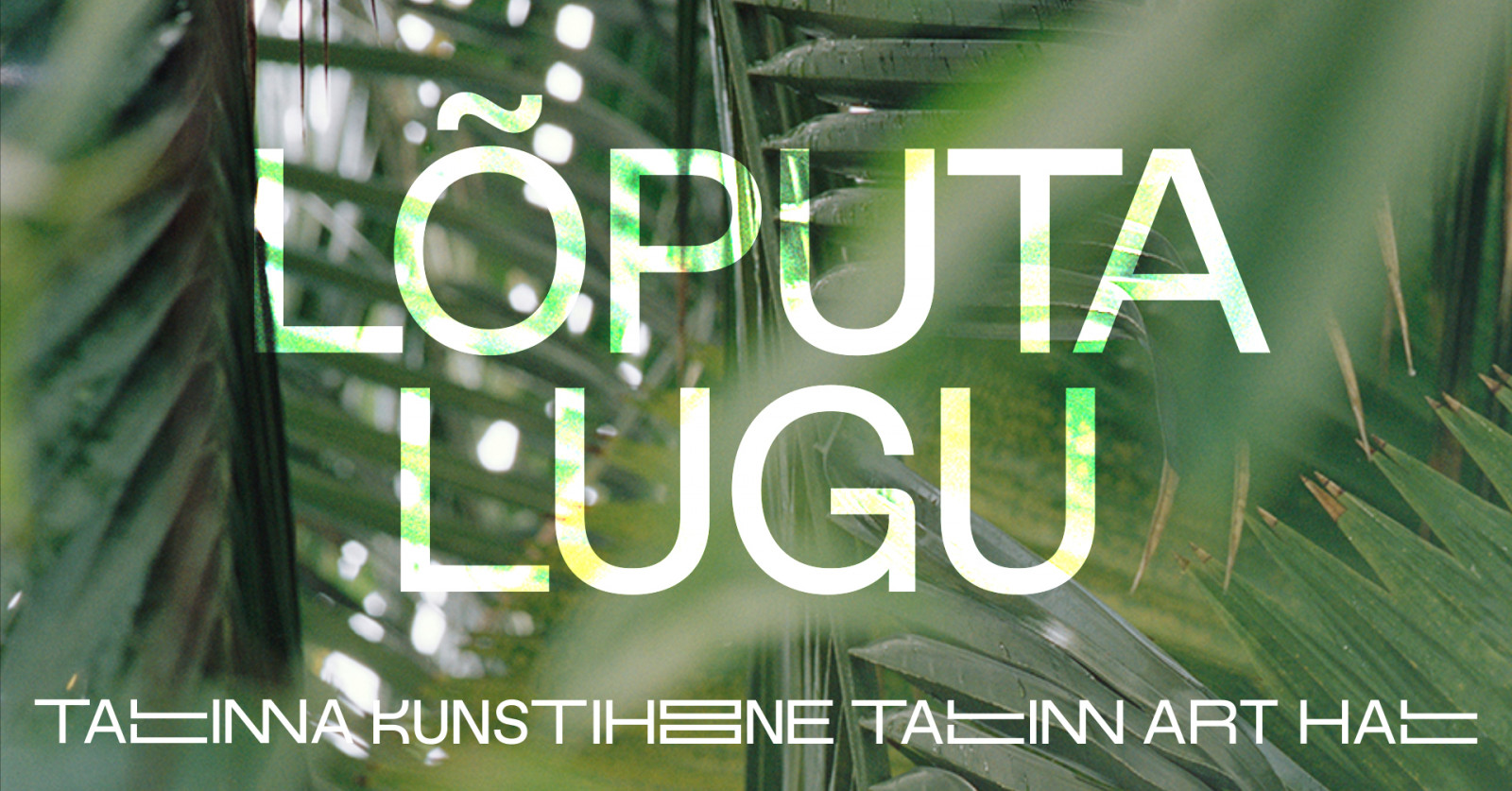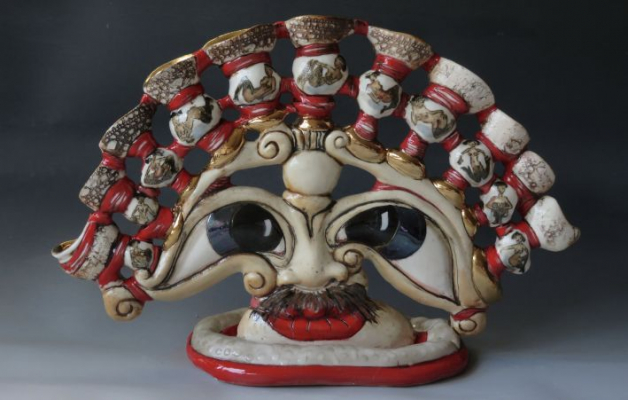
Baltic exhibition guide
March
TALLINN
Vello Vinn: Interreflections
KUMU exhibition spaces
14 February till 9 August

The works of Vello Vinn (1939) form a noteworthy example of the oeuvre of an Estonian printmaker from the late 1960s and early 1970s, and they boast a holistic and emphatically unique image system. Vinn’s highly original visual world is grounded in his mastery of various printmaking techniques, delicate treatment of images and witty associations. The artist’s play with space and images, his ability to notice details and different levels of meaning offer the public unique viewing experiences. Besides playful images, his works present witty wordplay and warm absurd humor. Through original imagery, the artist has addressed all of the topical issues of his time, including global military conflicts, the environmental impact of a technology-centered world, and the estrangement accompanying urbanization. He has done this through major philosophical generalizations that still ring true.
In order to show how Vello Vinn’s oeuvre has impacted Estonian art and visual culture, his works in this exposition have been placed in a dialogue with artworks of younger authors, which have mostly been created specifically for this exhibition. Mihkel Kleis displays paintings, prints and graphic designs that have been inspired by the symmetry and science-fictional images of Vinn’s illustrations. Lilli-Krõõt Repnau combines traditional printmaking techniques with contemporary dystopias. Kristina Õllek’s installation stems from Vinn’s work Rockets (1971), moving from the themes of Jules Verne’s science fiction to present-day marine studies. In his paintings, Kiwa has exploited the technique of conceptual error. Kiwa and Ragnar Neljandi have created a joint installation to amplify the principle of symmetry: the spaces and images in their project acquire a life of their own in endless reflections. Krista Mölder’s photo series focusses on the graphic art housed in the museum’s collection: showing how open and fragile unframed sheets can be and how ephemeral the experience of viewing them is. The graphic designer Brit Pavelson has received inspiration from the verbal part of Vinn’s oeuvre.
The exhibition is curated by Elnara Taidre.
Tom of Finland. The Darkroom
Fotografiska Tallinn
20 February till 18 April

Tom of Finland was an artist, who with his grunting desire and skill positively portrayed and drew excessively masculine, attractive, confident macho-men with extreme swelling muscles and giant dicks having sex with each other – dressed in all accessories imaginable within the uniform/ leather/ rubber gay porn fetish – thoroughly challenged his contemporary society. At the same time, he was regarded as the hottest trend among a small group of leather gays, where he spread happiness and horniness. All this in a time when homosexuality was criminalized and classified as a mental disorder, and often had to find its places anonymously in public spaces like parks and bathhouses. For hiding his identity Touko Laaksonen worked for years under various pseudonyms.
Early on he started to take and develop the photographic portraits that he himself called reference-pictures, in his own darkened simple home-studio and darkroom – having them developed elsewhere would be risking a prison. ”This never before shown treasure trove of images gives a deeper insight into how his skilfully drawn super-macho men were created. Each drawing could consist of several references from several different photographs. The drawings show the men always full of confidence, and always ready, since Tom of Finland’s art, for him, wasn’t about problematizing, but about desire and the right to express it”, said curator Berndt Arell
To Fotografiska, this is a brilliant example of how photography – besides standing on its own – often plays a part in many different kinds of creating. The story of The Darkroom – the first art exhibition where Tom of Finland’s photographs are also being shown – is in many ways a journey through time. From dark hidden rooms or parks to open and well-lit salons. Incidentally, this is where the name of the exhibition comes from.
“The Darkroom” shows us an artist that, without being very political himself, made a big impact on his contemporary society, with his drive to zestfully portray a homoerotic macho-dream. An artist who eventually reached world-wide fame and could leave the dark rooms to live in Los Angeles half of the year, where the leather gay lifestyle happened in the open – a result of the fight and societal change to decrease oppression towards LGBTQ-people that was happening parallel to his artistic life. That he would have contributed to this development was something he was both proud of and very humble about. This year it’s 100 years since Tom of Finland was born and the exhibition serves as the homage to the unknown aspect of his creation.
Mihkel Ilus and Paul Kuimet. Endless Story
Tallinn Art hall
7 March till 3 May

Endless Story brings new work by Mihkel Ilus and Paul Kuimet together under one roof. In this exhibition Ilus and Kuimet look at the invisible systems that drive our world, the former addressing local systems, the latter global, which despite the passing of time remain or are born once again in an almost identical form.
Ilus is a visual artist who uses the tools of a painter and in recent years his work has focused primarily on dissecting and questioning the art of painting, as such. In Kuimet’s work, which continues to make use of traditional photography in the form of slides, film and analog enlargements, architecture plays an important role both as the object of documentation, as well as the architectonic elements he uses in the exhibition space.
Superficially based on their methods, materials and creative ideas, the art practices of Ilus and Kuimet may not appear to have much in common. However, their work is united by the dedication and creative intensity which most clearly expresses itself in their fanaticism for their chosen media and techniques. The fields of painting and photography both endow their practitioners with numerous guidelines for the correct ways of behavior and choice of materials. For the painter, let the canvas be made of linen and the paint be oil. Manipulating analog photographs takes place, not in Photoshop, but with the skillful manipulation of light in the darkroom. And in the interests of an effect, it is also possible to lie a little.
The exhibition is curated by Siim Preiman.
RIGA
Kristīne Kutepova. Visions
Riga Art space
1 February till 29 March

The first such ambitious personal exhibition of the young painter Kristīne Kutepova will shape the image of the artist's individually visualized experiences, where equal attention is paid to the nuances of everyday life, and spiritual searches in Eastern philosophy. The content of Kristīne Kutepova’s paintings is infinitely wide. Colour, shape, and texture play the most important role in the painter's handwriting. Colour areas, their contrasts are most commonly arranged impulsively, freely and enthusiastically, using as miniature canvases and large formats. The artist's view of the various topics ranges from abstract to poetic visions, where even a conversation about the heaviest event can turn into a pleasant form.
The exhibition is curated by Luīze Lismane.
Helēna and Ivars Heinrihsons. Something like that (In the name of Love)
Riga Smallest Art gallery
14 February till 10 April

For the first time in their creative life, Helēna and Ivars Heinrihsons have created a joint, inseparable installation, particularly for the space of Riga Smallest Art gallery.
Conceptually, the installation covers questions about the artist's everyday life and creative space. By revealing several possible forms of love, the two painters talk about humane and romantic love, as well as about love for art and decision-making, in the name of creative fulfillment by showing their work in the small gallery space, artists form a dialogue between themselves by putting their creative ambitions in such narrow circumstances for the first time. At the same time, they are drawing attention to the fact that such a fixation of the scenes of marriage can be very personal, but sometimes obligatory for exposition to the public.
Paula Vītola. Waves – Lights – Shadows
Rixc gallery
28 February till 2 May

The exhibition's works show artistic experiments and attempts to understand through them seemingly self-evident phenomena - sound and light. By using light as a source for sound, it makes intangible and invisible phenomena visible and workable visually, opening up new possibilities for experimentation.
So far, the artist has created a variety of prototypes for obtaining sound with light - performance tools that can produce sounds using motors, strings, Christmas lights, water bottles, and other objects; a sound recorder using a mirror and sunlight instead of a microphone; as well as a device for listening to the sounds of insect wings.
The light used in the exhibition is used to create sound using the principle of photoacoustics, which was already discovered in 1880 by Alexander Graham Bell. During the exhibition, you can see the experiments of the artist - sketches of the process, prototypes and tools for sound creation will also be displayed. In the artworks, the creation of sound and experimentation becomes an exciting, playful process that the exhibition visitors will have the opportunity to try out.
Paula Vitola is an artist and lecturer at the University of Liepaja, mainly working in the field of media art and art research, as well as recently focusing on sound art. In her creative work, the artist is experimenting with different technologies, natural and physical phenomena, trying to understand them, finding new means of expression and ways to deal with them.
ITCH
gallery Istaba
9 till 28 March

Already from March 9 till March 28 gallery Istaba will present the group exhibition “ITCH”. The artworks for the show are specially made by 9 new generations visual artists who are unified under the flag of mental itch.
The visitors can experience the use of different art mediums, which gives a glimpse of contemporary art practices as well as the variety of irritations, itchy themes and the causes of it. Possibly some of them will feel familiar. Often the itch is so present that it becomes the connecting element within groups of people. For one it’s the protective reaction, others suffer from allergy already for ages, to another it is sick obsession or just the desire to itch together with others. Probably, you too had some cravings to itch lately.
The participants of the exhibition are both bachelor’s and master’s degree students from the Art Academy of Latvia as well as Latvian artists studying in Belgium and Island. Hitherto they have introduced themselves through various cultural fields to the Latvian Art scene.
For the period of the show, the space of gallery Istaba is also unusually changed within the conceptual theme. To fully immerse You into the widely itching world.
The creators of itchy case: Madara Bethere, Krišjānis Elviks, Anna Malicka, Liene Rumpe, Jānis Šnieders, Rūdolfs Štamers, Kristīne Upīte, Inese Zalviņa, Paula Zvane and curator Elīza Elizabete Ramza.
Skuja Braden. Samsara
Museum of Decorative Arts and Design
14 March till 3 May

The exhibition has been conceived marking the 21st anniversary of the artists' collaboration since their first exhibition together in Riga in 1999. That is when this creative tandem was established, and since then all their works have been signed with the surnames of both. The combination Skuja Braden symbolizes another, invented personality, a kind of bandit or thief, who has appropriated the identity of two authors. While both Ingūna Skuja (1965) and Melissa D. Braden (1968) exist, only Skuja Braden is truly well known in the art world. She literally exists in a third state – created and not created, real and unreal, her existence effectively dismantles the relationship between subject and object. This is an important aspect of the oeuvre of Ingūna Skuja and Melissa D. Braden as well as in the interpretation of their ideas.
Since the creation of Skuja Braden, the duo has been active in both Latvia and the United States, taking part in exhibitions in centers of ceramic art in European countries, Asia and Australia. the works of Skuja Braden are held in more than thirty collections in Latvia and internationally – belonging to museums, institutions, and organizations. Personal exhibitions are regularly organized in Latvia, paying particular attention to the regions, as well as abroad. Each year, Skuja Braden's creations are included in many prestigious group shows, juried exhibitions, and conceptual projects throughout the world, exciting and delighting porcelain aficionados from America to Australia.
Along with their technique, the content of Skuja Braden's work is just as explosive. Being feminists, defenders of LGBT, socially responsible and politically active individuals, Ingūna Skuja and Melissa D. Braden acutely record what is happening around them – people and events in culture, political shifts and the way that affects society and the individual – is all interpreted in their work. Skuja Braden takes the position of a militant critic or a loving supporter, but never remains neutral or stands aside. Such a conscious, loudly formulated and unapologetic position is unique in the Latvian art scene.
The dualism characteristic of Skuja Braden also takes another form: alongside pieces which are made as a reaction to the current physical reality, an important aspect of their work is activity influenced by Buddhism, acceptance, and reliance on an understanding of the eternal, the timeless.
The exhibition Samsara characterizes the way Skuja Braden understands and practices Buddhism. Originating in India, the core concept of Samsara is prevalent in Eastern religions, and is created through a false understanding of the mind which creates a false self that leads us through perpetual cycles of existence in the unreal world of Samsara. At the same time, samsara is the organizing principle of the exhibition space and the choreography of its perception – the prism through which to see and perceive the tandem's material creations.
The exhibition at the Museum of Decorative Arts and Design brings together more than 300 art objects from the museum and private collections.
VILNIUS
Head With Many Thoughts
Contemporary art center
14 February till 15 April

Last autumn, the Contemporary Art Centre in Vilnius announced an open call to participate in a group exhibition. The open call presented an opportunity to reflect upon the needs of the art field along with its community, and to explore new ways of working together. “We would like to make an experiment – to invite anyone and everyone to propose ideas, projects, events and processes,” the curators wrote in the invitation; anything that “seems important, interesting to share or to experience with others.”
More than 200 people from various countries responded to the invitation, among them not just professional artists; a small infinity which for the last couple of months have been testing the limits of the CAC. We are very grateful for such an overwhelming response; collectively, the proposals contributed a diverse range of ideas, projects and points of view and each was considered, discussed and thus in some way accepted. Some of the proposals will be implemented and presented in the future or otherwise woven into the fabric of the CAC’s future activities. Meanwhile, several dozen artists, curators and collectives will feature in the exhibition ‘Head With Many Thoughts’.
The exhibition is a polyvocal reflection on time, endings, beginnings, transition, and change. It offers no single vision for the future – neither hopeful nor threatening – nor one direction of movement: the present time is marked by a range of simultaneous trajectories and multiple choices. Knowing what exactly our actions will change is not always possible; nevertheless, it is important and no less interesting to look out for what is unfolding in front of us and to act. If the exhibition does not lie, it’s the gentle attentiveness, togetherness, and care that help us face the uncertainty; and one becomes the necessary “glue” by becoming support, springboard, and adventure for oneself and for others.
The original invitation posed the question “Are We Closing?” as its headline, and the exhibition was intended as one of the last projects presented at the CAC prior to a major renovation. The prospect of a hiatus became a pretext for self-reflection and an opening up of the institution, and the exhibition also carries a sense of leaping into the unknown. However, due to an unexpected change in the building’s renovation plan, repairs have been postponed and the CAC will continue to operate in its usual spaces for at least another year. But while the anticipated changes have been delayed, thoughts are picking up speed.
Linas Leonas Katinas. Red Becomes White Whilst Falling
National Gallery of art
6 March till 17 May

Linas Leonas Katinas (b. 1941) entered the field of painting at the end of the 1960s, to become one of the central artists of a generation marked by a chasm of experimental creativity, which was fostered by Brezhnev era stagnation. His creative biography, that spans almost six decades, never ceases to astonish with its sharp turns and transformations.
"Red Becomes White whilst Falling" invites the audience to gaze upon Katinas' mundus imaginalis: an imaginary world, wherein reflections on quotidian, historical and individual worldviews, cross with the mythic, archetypal and symbolic. Like a bird's nest, Katinas' world of painting is constructed from local materials in his environment -- the structure relying on and being dictated by, his intuition.
Further, his work utilizes abstraction, Tachisme, and elements of Conceptual art language while simultaneously drawing from spatial-structural thought processes acquired in the fields of architecture, theatre, and film.
Regardless, Katinas' works do not lack healthy wit, self-deprecation and a mischievous enjoyment of the sparks that flash when crossing the sacral with the profane. In such traits, we find the nuclei of both the primitive and the cultivated. Take the cosmological works, where notions of eternal-cyclical change prevail, returning one to a syncretic, mixed birth/renewal state.
Such qualities distinguish Katinas' work in both the Soviet and post-independence period of Lithuania. Having come to painting from architecture, he learned through his lived experience and research. The exponential conflict with the Soviet regime came to be expressed artistically through the absurd, escapist, spiritual; in Aesopian language, in carnival laughter. Similarly, but with an even greater scope, the artist developed his multi-layered riddles in the 1990s, which were filled with cultural references. Installations reminiscent of Arte Povera, projects in nature, two-sided paintings, and even musical experiments, bind together an organic dialogue with interdisciplinary ideas of art, hence following the principles of contemporary art.
As a cartographer attempts to represent the curved surface of the earth on a flat map, so this exhibition's curator has attempted to mark out the trajectories and transitions of the artist's works and some episodes of his life. Works of art, archival materials and visual documents exhibited in this exhibition mark out the path taken by the artist from the end of the 1970s to the present day.
Curator of the exhibition is Jolanta Marcišauskytė-Jurašienė.